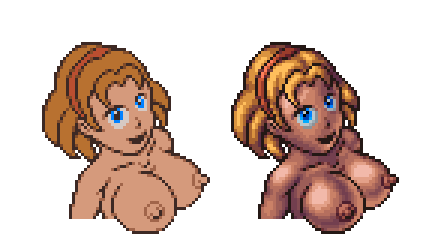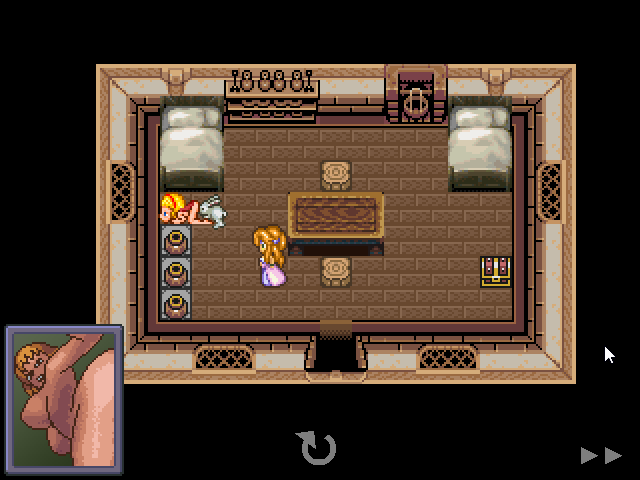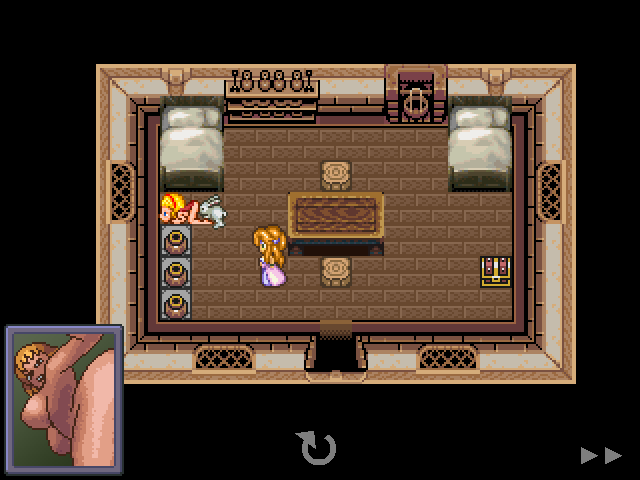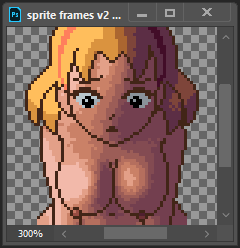This is a story about Ridinghood’s mom encouraging her to play with frisky bunnies
#
This story is part of a
 2 story set
. With similar themes but different characters. They don’t have any particular order. Just two versions of the same story idea.
2 story set
. With similar themes but different characters. They don’t have any particular order. Just two versions of the same story idea.
#
 Fairy Picnic
Fairy Picnic Bunny Picnic
Bunny Picnic
#
These scenarios were inspired by the concept of combining a rape-fantasy with complicit voyeurism. The idea of being ravished while someone else just watches and lets it happen amplifies how exciting the fantasy feels because it adds another layer of “entrapment” to the situation. Nobody is going to help you escape because everybody wants it to happen.
#
Obviously this only works in a fantasy where nobody can actually get hurt and everybody ends up having a good time. When the story focuses on a character you’re attracted to, the cause of that character’s arousal can be almost anything. I explain why below. And any “entrapment” elements amplify your anticipation because they make the outcome you’re seeking more certain.
#
I also made these stories to explore ways to create and use animations in my stories since I has just finished programming an animated portrait system for my textboxes.
#
This is the second story I created. Their plots are intentionally similar because I thought it would be interesting to compare a few different approaches. Making sprite animation in the lowest practical quality VS highest possible quality. And the difference between how I handle male characters and female characters.
#Making Sprite Animations
#
Let’s tackle the technical challenges first. I could have theoretically pushed the quality even higher with techniques like anti-aliasing, but I didn’t want to spend an eternity making these animations, so this actually just ended up being a step up rather than representing the absolute limits of my sprite-making skills. But I still learned some interesting techniques from these challenges.
#
First was dealing with inconsistency. After I had the flat-color animations “done” they clashed with the fully shaded talking portraits…
#
… So I had a choice. Either simplify the portraits to match the animations, or shade the animations to match the portraits.

#
Since the Bunny Picnic story represented the ambitious high-quality approach, I decided to shade all of its animations. But shading a single image already takes awhile, how do I shade an entire animation? And more importantly how do I make the shading consistent? The only way to find out was to just dive in.
#
As expected, the result was inconsistent with some flickering shading. But it actually turned out better than I expected it to.

#
So I went back and spent half an hour fixing the shading.

#
The problem was that fixing the shading took longer than adding it in the first place! It took 22 minutes to create okay flickery results, but an hour to create good consistent results. I’m not sure I liked that trade-off. I figured I might be able to shave that down slightly by being a little more careful while adding the shading, but then I remembered another trick I discovered a long time ago while making
 this picture
… combining multiple shading layers! How does that help? Well I can take advantage of the fact that these animation frames are similar to each another. The head and body don’t drastically change locations. They just shift around a tiny bit. So I can add some “general” shading that all the frames share, and then just add a few extra bits of shading for the parts that change.
this picture
… combining multiple shading layers! How does that help? Well I can take advantage of the fact that these animation frames are similar to each another. The head and body don’t drastically change locations. They just shift around a tiny bit. So I can add some “general” shading that all the frames share, and then just add a few extra bits of shading for the parts that change.
#
This worked much better than I expected! I didn’t even have to shade every little difference, just the biggest most noticeable parts. The frame-unique shading only required about 4 brush strokes. Which means there were only 4 parts to adjust when the frames didn’t quite match up. And with a little masking the combined result looks convincing enough to trick the eye into thinking that the shading is fully animated.

#Loli VS Shota
#
The other half of this experiment was comparing the differences in how I treat male and female characters in the same situations. To examine this, I created two versions of the same story. One with a boy and one with a girl.
#
 With girl characters I want to see them feeling horny and ultimately enjoying sex as intensely as possible. Aggressor characters are just convenient ways to cause this, but it could just as easily be something like tentacles. It accomplishes the same goal.
With girl characters I want to see them feeling horny and ultimately enjoying sex as intensely as possible. Aggressor characters are just convenient ways to cause this, but it could just as easily be something like tentacles. It accomplishes the same goal.
#
Sequence of events:
girl surprised by stimulus → horny and overwhelmed → happy sex pet
#
 With straight-shota I imagine myself as the boy characters, so I like to make the situations more rough. I’m indifferent about whether the boy character “consents” because they’re just a vehicle for the audience to experience the situation from, so I’m only interested in seeing them being pursued and ravished by beautiful women as aggressively as possible.
With straight-shota I imagine myself as the boy characters, so I like to make the situations more rough. I’m indifferent about whether the boy character “consents” because they’re just a vehicle for the audience to experience the situation from, so I’m only interested in seeing them being pursued and ravished by beautiful women as aggressively as possible.
#
Sequence of events:
surprised boy struggles → horny instinctive humping → afterglow
#
It’s a difference of perspective, but in both cases my focus is on the female characters’ actions and feelings. You could theoretically swap the genders to appeal to an opposite audience.

#
But comparing the two approaches, there is actually a surprising amount of similarity between them. So in theory I could make slight adjustments to a straight-shota story to make it more fun for an audience that likes boys. Just show the boy’s horny reactions more and make sure he is happy at the end. I could also make the loli story more fun for a female audience by making the girl struggle more at first. The only other difference is how human the aggressors look. I have a personal hang-up where I can’t stand seeing grown men pursuing girls, so I always use animals instead, but in theory a more human looking male aggressor might be fun eye-candy for some people.
#
But there are also other possible approaches:
#
This picture works both ways. People who relate to the boy feel loved by the woman’s attention, and people who like seeing boys have a fun reaction to look at.
 Art by Muraosamu
Art by Muraosamu
#
Happy sex is a less intense situation because it lacks the concept of being cornered, but it is more reassuring for every audience.
 Art by ArdanNorgate
Art by ArdanNorgate
#
#Viewpoint-Based Rape Fantasies
#
I say “viewpoint-based” because a rape fantasy might theoretically be approached from the perspective of the recipient or the perspective of the aggressor. But I struggle to comprehend the aggressor viewpoint, so I have no useful insights about that approach.

#
But if you relate to a character, imagining yourself in their place, then you simply experience the situation as yourself from their vantage point. But you take your own preferences along with you. Older women are used in straight-shota scenarios to suit the older audience’s preferences. They also help create an authority imbalance to put the viewpoint character into a sexy situation.

#
If a viewpoint character “does not consent,” it doesn’t matter because the audience is only experiencing their own feelings, not the character’s. The author designs the viewpoint character and designs their reactions for the sole purpose of leading a story to a satisfying situation for its intended audience. “Rape” fantasies accommodate the audience at the seeming expense of the viewpoint character, but that’s just an illusion. Stories are always planned in advance by their authors.

#
 That’s why it doesn’t feel like rape when sex occurs in a “rape” fantasy. Ironically the key to making these fantasies work is making them feel nothing like actual rape. It might be presented AS rape, but the audience is not fearing for their lives. Instead the feelings you experience are more like being cornered by someone beautiful and horny. Being desired by someone you like is actually a comforting feeling. You feel wanted. And enthusiastic sex is the most exciting kind of sex.
That’s why it doesn’t feel like rape when sex occurs in a “rape” fantasy. Ironically the key to making these fantasies work is making them feel nothing like actual rape. It might be presented AS rape, but the audience is not fearing for their lives. Instead the feelings you experience are more like being cornered by someone beautiful and horny. Being desired by someone you like is actually a comforting feeling. You feel wanted. And enthusiastic sex is the most exciting kind of sex.
#Image Sources
Images Used
Overall pose
 Created by: Yoshino Momiji
Created by: Yoshino Momiji
Overall pose
 Created by: Blue Gale
Created by: Blue Gale
Overall pose
 Created by: Tagro
Created by: Tagro
Overall pose
 Created by: Yoshino Momiji
Created by: Yoshino Momiji